非谓语动词考查特点及解题点拨
非谓语动词题的四大解题方法和八条经典原则

非谓语动词题的四大解题方法和八条经典原则非谓语动词题的四大解题步骤:一、分析句子结构,辨别“谓语与非谓语”二、找逻辑主语三、分析语态四、分析时态非谓语动词题的八条经典原则:原则一、用作目的状语,原则上要用不定式原则二、用于名词后作定语时,使用非谓语动词的原则是:用不定式,表示动作尚未发生; 用现在分词,表示动作正在进行; 用过去分词,表示动作已经发生,同时表示被动意义.原则三、用作伴随状语,原则上要用现在分词原则四:用作结果状语时,可用现在分词或不定式,其原则区别是,一般要用现在分词,表示结果在意料之中,不定式用作结果状语主要用于某些特定句式中或表示结果在意料之外原则五、凡是含有被动意义时,原则上要用过去分词(done)。
但是,如果所涉及的动作尚未发生,则用不定式的被动式(to be done);如果所涉及的动作正在进行,则用现在分词的被动式(being done) 原则六、非谓语动词作状语时,其逻辑主语原则上应与主句主语保持一致原则七、强调动作发生在主句谓语动作之前时,原则上要用完成式(根据情况可用不定式的完成式或现在分词的完成式)原则八、对于固定搭配,原则上按搭配习惯处理――――――――――――――――――原则一、用作目的状语,原则上要用不定式1. When asked why he went there, he said he was sent there _____ for a space flight. (2007江西卷)A. trainingB. being trainedC. to have trainedD. to be trained【解析】答案选D。
由于进行航空飞行训练是他被派往那儿的目的,所以要用不定式,因此可排除A 和B。
另外,由于“他”与“训练”之间为被动关系,故选 D。
2. _____ this cake,you’ll need 2 eggs, 175 g sugar and 175 g flour. (2006广东卷)A. Having madeB. MakeC. To makeD. Making【解析】答案选C。
高考英语:非谓语动词考点精华讲义
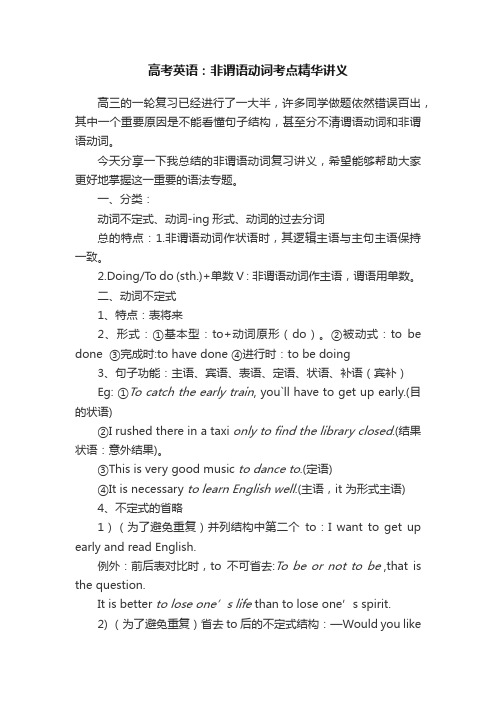
高考英语:非谓语动词考点精华讲义高三的一轮复习已经进行了一大半,许多同学做题依然错误百出,其中一个重要原因是不能看懂句子结构,甚至分不清谓语动词和非谓语动词。
今天分享一下我总结的非谓语动词复习讲义,希望能够帮助大家更好地掌握这一重要的语法专题。
一、分类:动词不定式、动词-ing形式、动词的过去分词总的特点:1.非谓语动词作状语时,其逻辑主语与主句主语保持一致。
2.Doing/T o do (sth.)+单数V : 非谓语动词作主语,谓语用单数。
二、动词不定式1、特点:表将来2、形式:①基本型:to+动词原形(do)。
②被动式:to be done ③完成时:to have done ④进行时:to be doing3、句子功能:主语、宾语、表语、定语、状语、补语(宾补)Eg: ①To catch the early train, you`ll have to get up early.(目的状语)②I rushed there in a taxi only to find the library closed.(结果状语:意外结果)。
③This is very good music to dance to.(定语)④It is necessary to learn English well.(主语,it 为形式主语)4、不定式的省略1)(为了避免重复)并列结构中第二个to:I want to get up early and read English.例外:前后表对比时,to不可省去:To be or not to be ,that is the question.It is better to lose one’s life than to lose one’s spirit.2) (为了避免重复)省去to后的不定式结构:—Would you liketo go shopping?—Yes,I`d like to.例外:to后有have/be时,保留be或have—Did you go shopping yesterday? —No, but I ought to have.5、不定式主动形式表被动意义1)主(sth)+ be + 主补/表语(表性质的adj. + to do)2) 主+Vt + 宾语 + 宾补(adj.+ to do)3) 主 + Vt+ 宾语+定语(to do): 不定式作定语与所修饰的名词(代词)构成逻辑动宾关系,又和该句主语构成逻辑上的主谓关系。
高二英语语法考点归纳:非谓语动词
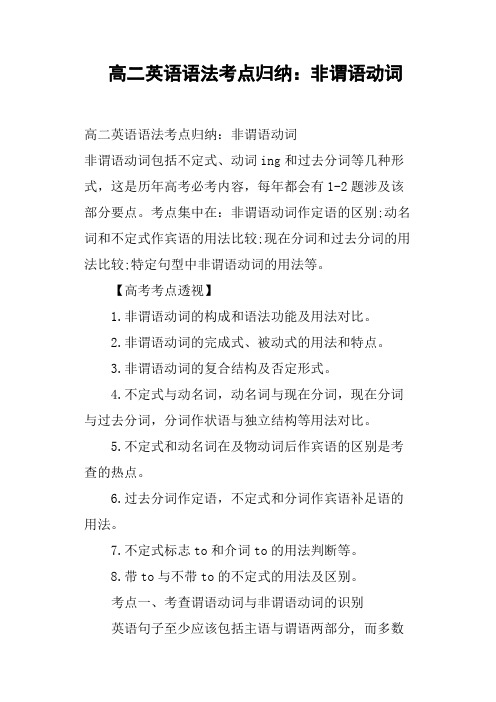
高二英语语法考点归纳:非谓语动词高二英语语法考点归纳:非谓语动词非谓语动词包括不定式、动词ing和过去分词等几种形式,这是历年高考必考内容,每年都会有1-2题涉及该部分要点。
考点集中在:非谓语动词作定语的区别;动名词和不定式作宾语的用法比较;现在分词和过去分词的用法比较;特定句型中非谓语动词的用法等。
【高考考点透视】1.非谓语动词的构成和语法功能及用法对比。
2.非谓语动词的完成式、被动式的用法和特点。
3.非谓语动词的复合结构及否定形式。
4.不定式与动名词,动名词与现在分词,现在分词与过去分词,分词作状语与独立结构等用法对比。
5.不定式和动名词在及物动词后作宾语的区别是考查的热点。
6.过去分词作定语,不定式和分词作宾语补足语的用法。
7.不定式标志to和介词to的用法判断等。
8.带to与不带to的不定式的用法及区别。
考点一、考查谓语动词与非谓语动词的识别英语句子至少应该包括主语与谓语两部分, 而多数情况下谓语都由动词来充当。
如果对句子成分划分不清,把谓语动词与非谓语动词混淆, 做题效果可想而知。
要克服这一毛病,关键在于正确判断、识别动词在句中是否充当谓语。
如:1. The children (play) _____ the violin ovwill gage next w 根据句子结构,我们可以看出这是一个简单句。
主语是The children,谓语部分是will gage,动词play显然在句中不作谓语,应用非谓语动词形式。
依据play与它的逻辑主语children之间的主动关系以及拉小提琴动作正在进行,可以判断用现在分词作定语修饰children,意为“正在那边拉小提琴的小孩”,因而正确答案为playing。
考点二、考查作状语的非谓语动词的辨析作状语的非谓语动词主要考查其各种形式的辨析,即是选择动词不定式、现在分词还是过去分词作状语,不同的状语对非谓语动词的要求不同。
动词不定式主要作目的、结果和原因状语;现在分词和过去分词主要作时间、原因、条件、让步、方式和伴随状语,两者不同之处在于:现在分词作状语时,现在分词的动作就是句子主语的动作,即它的逻辑主语就是句子的主语,它们之间的关系是主动关系,而过去分词作状语时,虽然它的逻辑主语也是句子的主语,但过去分词表示的动作是句子主语承受的动作,它们之间的关系是被动关系。
【高考英语语法】(非谓语动词)考查特点和答题技巧(Ⅰ)
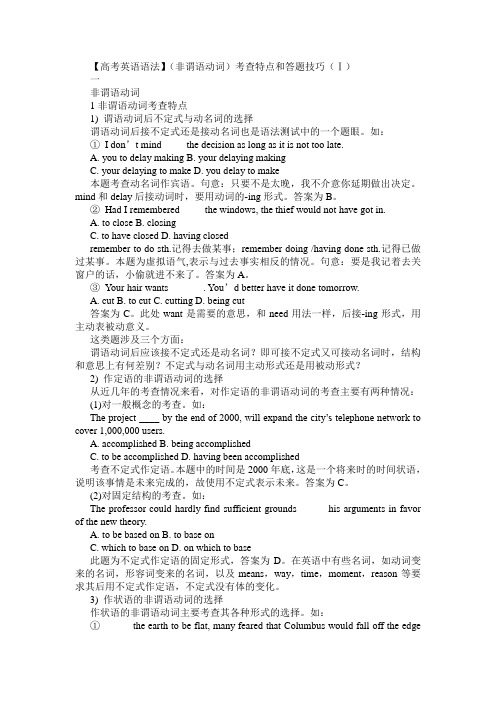
【高考英语语法】(非谓语动词)考查特点和答题技巧(Ⅰ)一非谓语动词1非谓语动词考查特点1) 谓语动词后不定式与动名词的选择谓语动词后接不定式还是接动名词也是语法测试中的一个题眼。
如:①I don’t mind ____ the decision as long as it is not too late.A. you to delay makingB. your delaying makingC. your delaying to makeD. you delay to make本题考查动名词作宾语。
句意:只要不是太晚,我不介意你延期做出决定。
mind和delay后接动词时,要用动词的-ing形式。
答案为B。
②Had I remembered ____ the windows, the thief would not have got in.A. to closeB. closingC. to have closedD. having closedremember to do sth.记得去做某事;remember doing /having done sth.记得已做过某事。
本题为虚拟语气,表示与过去事实相反的情况。
句意:要是我记着去关窗户的话,小偷就进不来了。
答案为A。
③Your hair wants ______ . You’d better have it done tomorrow.A. cutB. to cutC. cuttingD. being cut答案为C。
此处want是需要的意思,和need用法一样,后接-ing形式,用主动表被动意义。
这类题涉及三个方面:谓语动词后应该接不定式还是动名词?即可接不定式又可接动名词时,结构和意思上有何差别?不定式与动名词用主动形式还是用被动形式?2) 作定语的非谓语动词的选择从近几年的考查情况来看,对作定语的非谓语动词的考查主要有两种情况:(1)对一般概念的考查。
如何判断非谓语动词讲解

如何判断非谓语动词讲解非谓语动词是指在句子中具有动词性质,但不作谓语的动词形式。
在判断非谓语动词时,我们可以注意以下几个要点:1. 结构特征:非谓语动词通常由动词原形或动词的-ing、-ed、-en等形式构成。
常见的非谓语动词形式包括:不定式、现在分词、过去分词。
2. 句法功能:非谓语动词可以作为主语、宾语、定语、表语或状语等句子成分。
根据其在句子中的作用,我们可以判断非谓语动词的句法功能。
3. 语义特征:非谓语动词往往具有较强的动作性或状态性。
根据上下文的语义,我们可以推测非谓语动词所表达的动作或状态的特点。
以下是一些常见的非谓语动词及其用法的参考内容:1. 不定式(to + 动词原形):- 作主语:To learn a foreign language well requires a lot of practice.(学好一门外语需要大量的练习。
)- 作宾语:I want to go shopping this weekend.(这周末我想去购物。
)- 作定语:The best way to solve the problem is to ask for help.(解决问题的最好方式是寻求帮助。
)- 作状语:He woke up early to catch the first bus.(为了赶上第一辆公交车,他早早醒来。
)2. 现在分词(动词-ing形式):- 作主语:Painting is my favorite hobby.(绘画是我最喜欢的爱好。
)- 作宾语:I enjoy reading books in my free time.(我喜欢在闲暇时间读书。
)- 作定语:The running water is very clear.(流动的水非常清澈。
)- 作状语:Smiling, she accepted the award.(她微笑着接受了奖励。
)3. 过去分词(动词-ed或-en形式):- 作主语:Broken glass should be handled with care.(破碎的玻璃应小心处理。
非谓语动词习题答题技巧
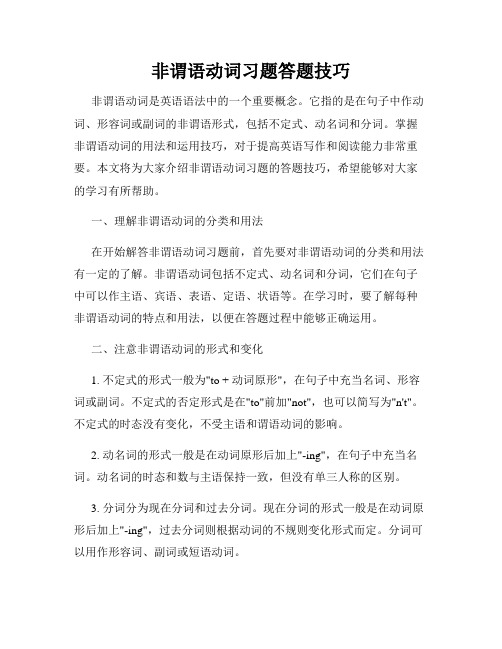
非谓语动词习题答题技巧非谓语动词是英语语法中的一个重要概念。
它指的是在句子中作动词、形容词或副词的非谓语形式,包括不定式、动名词和分词。
掌握非谓语动词的用法和运用技巧,对于提高英语写作和阅读能力非常重要。
本文将为大家介绍非谓语动词习题的答题技巧,希望能够对大家的学习有所帮助。
一、理解非谓语动词的分类和用法在开始解答非谓语动词习题前,首先要对非谓语动词的分类和用法有一定的了解。
非谓语动词包括不定式、动名词和分词,它们在句子中可以作主语、宾语、表语、定语、状语等。
在学习时,要了解每种非谓语动词的特点和用法,以便在答题过程中能够正确运用。
二、注意非谓语动词的形式和变化1. 不定式的形式一般为"to + 动词原形",在句子中充当名词、形容词或副词。
不定式的否定形式是在"to"前加"not",也可以简写为"n't"。
不定式的时态没有变化,不受主语和谓语动词的影响。
2. 动名词的形式一般是在动词原形后加上"-ing",在句子中充当名词。
动名词的时态和数与主语保持一致,但没有单三人称的区别。
3. 分词分为现在分词和过去分词。
现在分词的形式一般是在动词原形后加上"-ing",过去分词则根据动词的不规则变化形式而定。
分词可以用作形容词、副词或短语动词。
三、掌握非谓语动词的常见搭配和用法在答题过程中,要注意掌握非谓语动词的常见搭配和用法。
下面列举一些常见的搭配和用法:1. 不定式常与短语动词搭配,如"agree to"、"decide to"、"plan to"等。
2. 动名词常与介词搭配,如"be interested in"、"look forward to"、"depend on"等。
【高考英语语法】(非谓语动词)考查特点与答题技巧Ⅱ
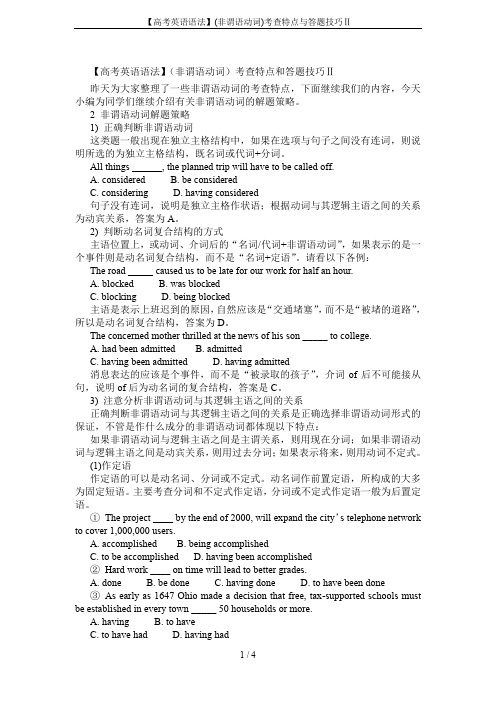
【高考英语语法】(非谓语动词)考查特点和答题技巧Ⅱ昨天为大家整理了一些非谓语动词的考查特点,下面继续我们的内容,今天小编为同学们继续介绍有关非谓语动词的解题策略。
2 非谓语动词解题策略1) 正确判断非谓语动词这类题一般出现在独立主格结构中,如果在选项与句子之间没有连词,则说明所选的为独立主格结构,既名词或代词+分词。
All things ______, the planned trip will have to be called off.A. consideredB. be consideredC. consideringD. having considered句子没有连词,说明是独立主格作状语;根据动词与其逻辑主语之间的关系为动宾关系,答案为A。
2) 判断动名词复合结构的方式主语位置上,或动词、介词后的“名词/代词+非谓语动词”,如果表示的是一个事件则是动名词复合结构,而不是“名词+定语”。
请看以下各例:The road _____ caused us to be late for our work for half an hour.A. blockedB. was blockedC. blockingD. being blocked主语是表示上班迟到的原因,自然应该是“交通堵塞”,而不是“被堵的道路”,所以是动名词复合结构,答案为D。
The concerned mother thrilled at the news of his son _____ to college.A. had been admittedB. admittedC. having been admittedD. having admitted消息表达的应该是个事件,而不是“被录取的孩子”,介词of后不可能接从句,说明of后为动名词的复合结构,答案是C。
3) 注意分析非谓语动词与其逻辑主语之间的关系正确判断非谓语动词与其逻辑主语之间的关系是正确选择非谓语动词形式的保证,不管是作什么成分的非谓语动词都体现以下特点:如果非谓语动词与逻辑主语之间是主谓关系,则用现在分词;如果非谓语动词与逻辑主语之间是动宾关系,则用过去分词;如果表示将来,则用动词不定式。
非谓语动词的高考命题特点与解题技巧
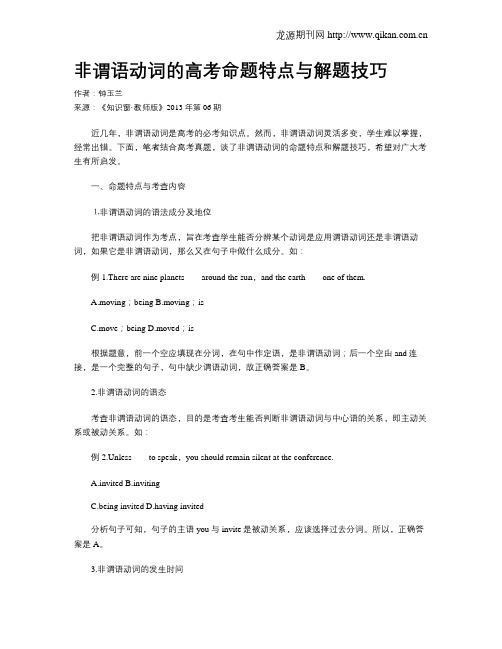
非谓语动词的高考命题特点与解题技巧作者:钟玉兰来源:《知识窗·教师版》2013年第06期近几年,非谓语动词是高考的必考知识点。
然而,非谓语动词灵活多变,学生难以掌握,经常出错。
下面,笔者结合高考真题,谈了非谓语动词的命题特点和解题技巧,希望对广大考生有所启发。
一、命题特点与考查内容⒈非谓语动词的语法成分及地位把非谓语动词作为考点,旨在考查学生能否分辨某个动词是应用谓语动词还是非谓语动词,如果它是非谓语动词,那么又在句子中做什么成分。
如:例1.There are nine planets____around the sun,and the earth____one of them.A.moving;beingB.moving;isC.move;beingD.moved;is根据题意,前一个空应填现在分词,在句中作定语,是非谓语动词;后一个空由and连接,是一个完整的句子,句中缺少谓语动词,故正确答案是B。
2.非谓语动词的语态考查非谓语动词的语态,目的是考查考生能否判断非谓语动词与中心语的关系,即主动关系或被动关系。
如:例2.Unless____to speak,you should remain silent at the conference.A.invitedB.invitingC.being invitedD.having invited分析句子可知,句子的主语you与invite是被动关系,应该选择过去分词。
所以,正确答案是A。
3.非谓语动词的发生时间考查非谓语动词的发生时间,目的是考查考生能否辨析非谓语动词发生在句子谓语动词之前、之后还是同时发生。
如:例3.____from heart trouble for years,Professor White has to take some medicine with him wherever he goes.A.SufferedB.SufferingC.Having sufferedD.Being suffered根据题意,状语for years表明suffer发生在has to take some medicine之前,故应该用完成时,所以答案是C。
「透析」高考英语复习:非谓语动词考点透析及解题技巧
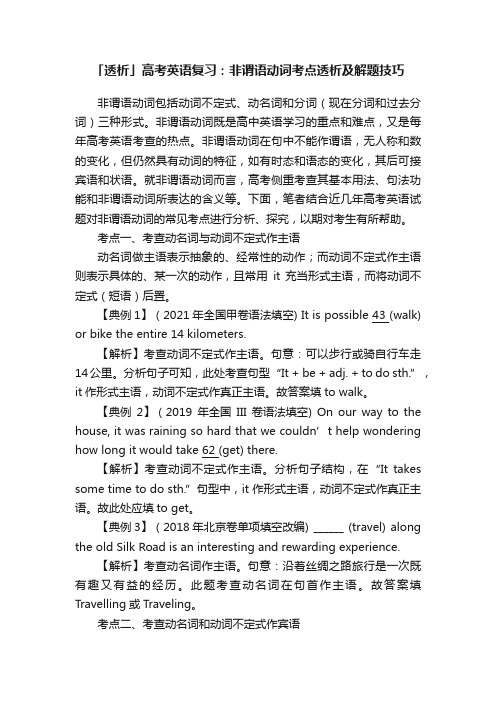
「透析」高考英语复习:非谓语动词考点透析及解题技巧非谓语动词包括动词不定式、动名词和分词(现在分词和过去分词)三种形式。
非谓语动词既是高中英语学习的重点和难点,又是每年高考英语考查的热点。
非谓语动词在句中不能作谓语,无人称和数的变化,但仍然具有动词的特征,如有时态和语态的变化,其后可接宾语和状语。
就非谓语动词而言,高考侧重考查其基本用法、句法功能和非谓语动词所表达的含义等。
下面,笔者结合近几年高考英语试题对非谓语动词的常见考点进行分析、探究,以期对考生有所帮助。
考点一、考查动名词与动词不定式作主语动名词做主语表示抽象的、经常性的动作;而动词不定式作主语则表示具体的、某一次的动作,且常用it 充当形式主语,而将动词不定式(短语)后置。
【典例1】(2021年全国甲卷语法填空) It is possible 43 (walk) or bike the entire 14 kilometers.【解析】考查动词不定式作主语。
句意:可以步行或骑自行车走14公里。
分析句子可知,此处考查句型“It + be + adj. + to do sth.”,it作形式主语,动词不定式作真正主语。
故答案填to walk。
【典例2】(2019年全国III卷语法填空) On our way to the house, it was raining so hard that we couldn’t help wondering how long it would take 62 (get) there.【解析】考查动词不定式作主语。
分析句子结构,在“It takes some time to do sth.”句型中,it 作形式主语,动词不定式作真正主语。
故此处应填to get。
【典例3】(2018年北京卷单项填空改编) ______ (travel) along the old Silk Road is an interesting and rewarding experience.【解析】考查动名词作主语。
英语非谓语重难点考点总结
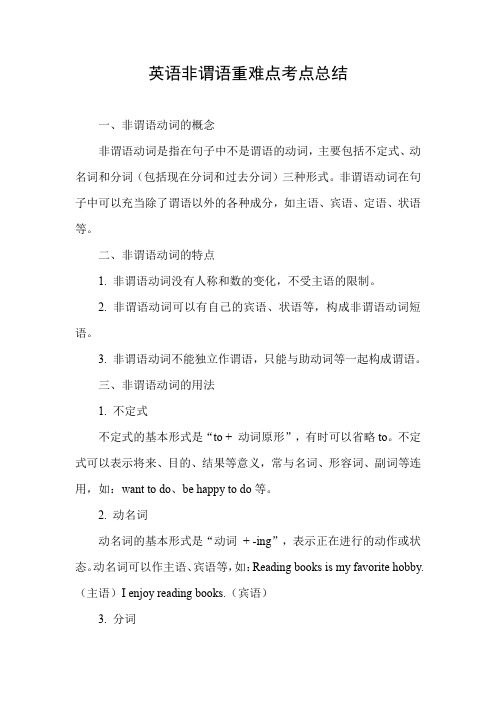
英语非谓语重难点考点总结一、非谓语动词的概念非谓语动词是指在句子中不是谓语的动词,主要包括不定式、动名词和分词(包括现在分词和过去分词)三种形式。
非谓语动词在句子中可以充当除了谓语以外的各种成分,如主语、宾语、定语、状语等。
二、非谓语动词的特点1. 非谓语动词没有人称和数的变化,不受主语的限制。
2. 非谓语动词可以有自己的宾语、状语等,构成非谓语动词短语。
3. 非谓语动词不能独立作谓语,只能与助动词等一起构成谓语。
三、非谓语动词的用法1. 不定式不定式的基本形式是“to + 动词原形”,有时可以省略to。
不定式可以表示将来、目的、结果等意义,常与名词、形容词、副词等连用,如:want to do、be happy to do等。
2. 动名词动名词的基本形式是“动词+ -ing”,表示正在进行的动作或状态。
动名词可以作主语、宾语等,如:Reading books is my favorite hobby.(主语)I enjoy reading books.(宾语)3. 分词分词分为现在分词和过去分词两种形式。
现在分词的基本形式是“动词+ -ing”,表示正在进行的动作或状态;过去分词的基本形式是“动词+ -ed”,表示已经完成的状态或动作。
分词可以作定语、状语等,如:the exciting match(定语)、the match finished at 8:00(状语)。
四、非谓语动词的难点考点1. 非谓语动词作主语的判断非谓语动词作主语时,主要判断该句子缺什么成分,如果缺主语,就可以考虑使用动名词或不定式。
例如:____(see)is believing. 这句话缺少主语,可以使用动名词或不定式,但根据句意“眼见为实”,应该使用动名词。
2. 非谓语动词作宾语的判断非谓语动词作宾语时,主要判断该动作与句子主语的关系。
如果该动作是句子主语的主动行为,则使用不定式;如果该动作是句子主语的被动行为,则使用动名词。
(详细版)非谓语动词总结要点

(详细版)非谓语动词总结要点非谓语动词总结要点一、非谓语动词的基本概念非谓语动词是指在句子中充当动词的成分,但不具备时态和人称变化。
常见的非谓语动词包括动词不定式、动名词和分词。
二、动词不定式的特点和用法1. 动词不定式的特点:不定式一般由to + 动词原形构成。
2. 动词不定式的用法:- 作主语:To travel around the world is my dream.- 作宾语:She loves to sing and dance.- 作宾语补足语:They want me to join their team.- 作状语:I study hard to improve my English.- 与某些动词连用,如hope, expect, want, agree等:I hope to see you soon.三、动名词的特点和用法1. 动名词的特点:动名词一般由动词-ing形式构成。
2. 动名词的用法:- 作主语:Swimming is good for your health.- 作宾语:I enjoy reading books.- 作宾语补足语:She found pleasure in helping others.- 作定语:The running water sounds relaxing.四、分词的特点和用法1. 分词的特点:分词形式有现在分词(-ing形式)和过去分词(-ed或其他形式)。
2. 分词的用法:- 现在分词作状语:Seeing the accident, he hurried to call an ambulance.- 过去分词作定语:The broken window needs to be repaired.五、非谓语动词的时态和语态非谓语动词没有时态和人称变化,但可以与助动词连用,表示完成、进行、将来等不同的时态。
同时,非谓语动词也可以使用被动语态。
非谓语动词在高考中的考点及易错点(详解)
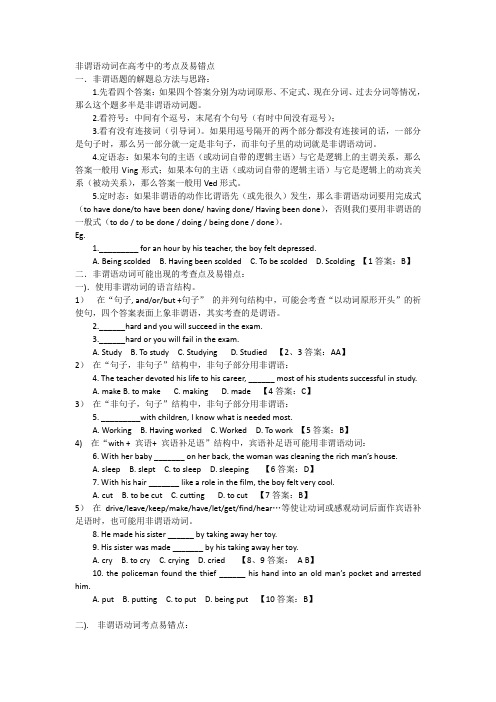
非谓语动词在高考中的考点及易错点一.非谓语题的解题总方法与思路:1.先看四个答案:如果四个答案分别为动词原形、不定式、现在分词、过去分词等情况,那么这个题多半是非谓语动词题。
2.看符号:中间有个逗号,末尾有个句号(有时中间没有逗号);3.看有没有连接词(引导词)。
如果用逗号隔开的两个部分都没有连接词的话,一部分是句子时,那么另一部分就一定是非句子,而非句子里的动词就是非谓语动词。
4.定语态:如果本句的主语(或动词自带的逻辑主语)与它是逻辑上的主谓关系,那么答案一般用Ving形式;如果本句的主语(或动词自带的逻辑主语)与它是逻辑上的动宾关系(被动关系),那么答案一般用Ved形式。
5.定时态:如果非谓语的动作比谓语先(或先很久)发生,那么非谓语动词要用完成式(to have done/to have been done/ having done/ Having been done),否则我们要用非谓语的一般式(to do / to be done / doing / being done / done)。
Eg.1._________ for an hour by his teacher, the boy felt depressed.A. Being scoldedB. Having been scoldedC. To be scoldedD. Scolding 【1答案:B】二.非谓语动词可能出现的考查点及易错点:一).使用非谓动词的语言结构。
1)在“句子, and/or/but +句子”的并列句结构中,可能会考查“以动词原形开头”的祈使句,四个答案表面上象非谓语,其实考查的是谓语。
2.______hard and you will succeed in the exam.3.______hard or you will fail in the exam.A. StudyB. To studyC. StudyingD. Studied 【2、3答案:AA】2)在“句子,非句子”结构中,非句子部分用非谓语:4. The teacher devoted his life to his career, ______ most of his students successful in study.A. makeB. to makeC. makingD. made 【4答案:C】3)在“非句子,句子”结构中,非句子部分用非谓语:5. _________with children, I know what is needed most.A. WorkingB. Having workedC. WorkedD. To work 【5答案:B】4) 在“with + 宾语+ 宾语补足语”结构中,宾语补足语可能用非谓语动词:6. With her baby _______ on her b ack, the woman was cleaning the rich man’s house.A. sleepB. sleptC. to sleepD. sleeping 【6答案:D】7. With his hair _______ like a role in the film, the boy felt very cool.A. cutB. to be cutC. cuttingD. to cut 【7答案:B】5)在drive/leave/keep/make/have/let/get/find/hear…等使让动词或感观动词后面作宾语补足语时,也可能用非谓语动词。
非谓语动词答题策略指导

非谓语动词答题策略指导非谓语动词是英语语法中的一个重要概念,也是英语考试中经常会出现的题型。
正确使用非谓语动词可以提升文章的表达力和准确性。
本文将为大家介绍一些答题策略,帮助大家在考试中正确运用非谓语动词。
一、什么是非谓语动词非谓语动词是指不能独立充当谓语,而只能在句子中作其他成分的动词形式。
非谓语动词包括动词不定式、动名词和分词。
二、动词不定式1. 定义与构成动词不定式由动词原形加上“to”构成,例如:to go,to play。
2. 用途与形式动词不定式的用途非常广泛,常用于以下几个方面:(1) 作主语:To study is important.(2) 作宾语:I want to go.(3) 作表语:My dream is to be a singer.(4) 作状语:I got up early to catch the train.3. 注意事项在使用动词不定式时,需要注意以下几点:(1) 在情态动词后使用动词不定式时,不需要加上“to”,例如:You should study hard.(2) 动词不定式可以被其他修饰成分所修饰,例如:I want to quickly finish my homework.三、动名词1. 定义与构成动名词由动词原形加上“-ing”构成,例如:going,playing。
2. 用途与形式动名词的用途主要有以下几个方面:(1) 作主语:Reading is my hobby.(2) 作宾语:I enjoy swimming.(3) 作表语:His job is teaching English.(4) 作定语:The running water is very clear.3. 注意事项在使用动名词时,需要注意以下几点:(1) 有些动词后只能接动名词作宾语,例如:enjoy,finish。
(2) 动名词可以与其他名词构成复合结构,例如:a swimming pool,a running shoe。
非谓语动词重难点全面讲解含高考真题再现!
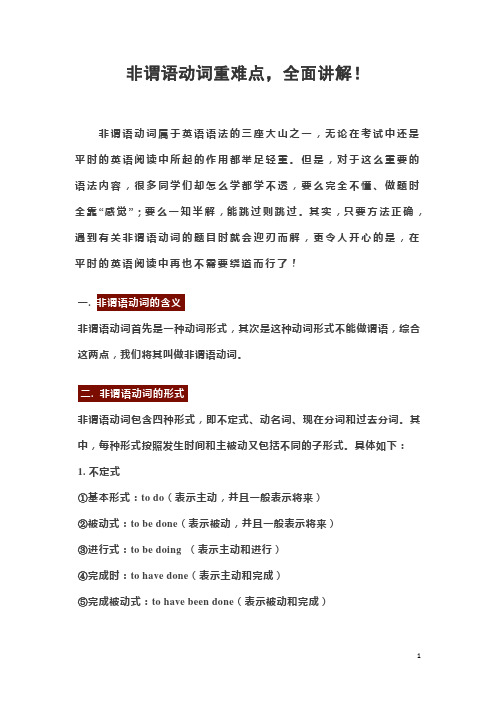
非谓语动词重难点,全面讲解!非谓语动词属于英语语法的三座大山之一,无论在考试中还是平时的英语阅读中所起的作用都举足轻重。
但是,对于这么重要的语法内容,很多同学们却怎么学都学不透,要么完全不懂、做题时全靠“感觉”;要么一知半解,能跳过则跳过。
其实,只要方法正确,遇到有关非谓语动词的题目时就会迎刃而解,更令人开心的是,在平时的英语阅读中再也不需要绕道而行了!一.非谓语动词首先是一种动词形式,其次是这种动词形式不能做谓语,综合这两点,我们将其叫做非谓语动词。
非谓语动词包含四种形式,即不定式、动名词、现在分词和过去分词。
其中,每种形式按照发生时间和主被动又包括不同的子形式。
具体如下:1. 不定式①基本形式:to do(表示主动,并且一般表示将来)②被动式:to be done(表示被动,并且一般表示将来)③进行式:to be doing (表示主动和进行)④完成时:to have done(表示主动和完成)⑤完成被动式:to have been done(表示被动和完成)⑥完成进行式:to have been doing (表示主动和完成进行)例如:The teacher told us to do morning exercises . 老师让我们做早操。
The car to be bought is for his sister.要买的这辆车是给他的姐姐的。
She pretended to be reading when the teacher came into the classroom.老师进来时,她假装正在读书。
The thief is said to have escaped.据说小偷已经逃跑了。
The thief is said to have been arrested.据说小偷已经被抓住了。
She is said to have been working in the factory over the last 20 years.据说在过去的20年里,她一直在这家工厂工作。
非谓语动词解题点穴法

非谓语动词解题点穴法定义:我们把在句子中充当除谓语动词以外的动词形式称作谓语动词。
分类:动名词(doing),不定式(to do),过去分词(done),不能作谓语,却在句子中充当主语、宾语、表语、定语、状语、补语等。
非谓语动词产生的原因:英语中,一句话里面,若无连词,有且只有一个谓语动词。
若要有两个动词,只能是一个谓语,一个非谓语。
一、表现形式考点分析1、非谓语作主语、谓语动词用单数;doing 和to do 可作主语,但含义不同;doing作主语往往表示一种习惯性经常性的动作;to do 作主语却表示一次性的动作;当doing和to作主语太长时可用it作形式主语,而把真正的主语放在后面。
【例】Painting is his hobby. 绘画是他的爱好。
It is no use waiting here.在这儿等是没用的。
固定句型:it is no use /useless doing sthit is no good doing sthit is a waste of time/money doing sthit is worthwhile doing sth.2、to do 作主语动词不定式短语作主语时,常用it作形式主语,真正的主语不定式置于句后。
【例】To finish the work in ten minutes is very hardIt is very hard to finish the work in ten minutes.固定句型it is+形容词+ to do sth.表示主观的形容词:important、hard、easy等。
it takes/took sb +time/money+to do sth.it is +形容词+of sb+to do sth表示人品质的形容词:good、clever、nice等。
二、to do 作宾语下列动词只能跟to do 作宾语hopewish,manage,fail,afford,arrange,ask,agree,aim,beg,decide,demand,happen,long,offer,pretend,pretend,prepare,plan等三、既可跟doing也可跟to do 的情况stop doing sth 表示停止做正在做的事儿stop to do sth 表示停止做某事去做另一件事儿forget doing 忘记做过某事forget to do 忘记要做某事remember doing 记得做过某事remember to do 记得去做某事regret doing 对做过的事儿感到遗憾,后悔regret to do 对将要做的事儿表示遗憾can't help to do sth无能为力做某事can't help doing sth情不自禁做某事go on to do sth 继续做另外一件事go on doing sth 继续做同一件事非谓语动词作宾语宾语可分作两类,动词宾语和介词短语。
高考对非谓语动词的考查
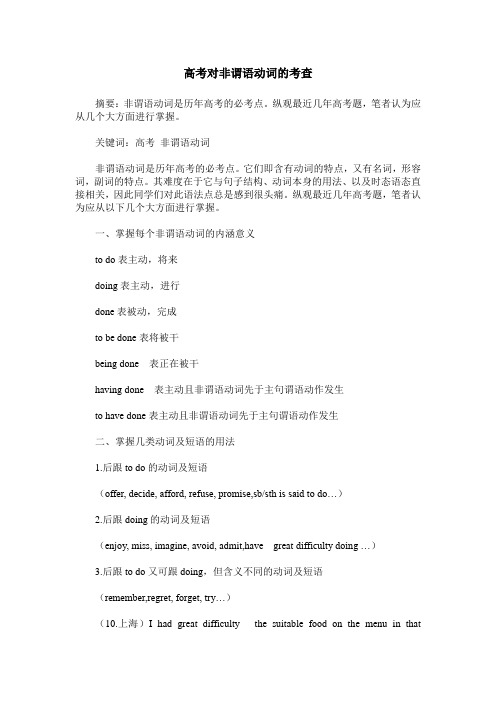
高考对非谓语动词的考查摘要:非谓语动词是历年高考的必考点。
纵观最近几年高考题,笔者认为应从几个大方面进行掌握。
关键词:高考非谓语动词非谓语动词是历年高考的必考点。
它们即含有动词的特点,又有名词,形容词,副词的特点。
其难度在于它与句子结构、动词本身的用法、以及时态语态直接相关,因此同学们对此语法点总是感到很头痛。
纵观最近几年高考题,笔者认为应从以下几个大方面进行掌握。
一、掌握每个非谓语动词的内涵意义to do表主动,将来doing表主动,进行done表被动,完成to be done表将被干being done 表正在被干having done 表主动且非谓语动词先于主句谓语动作发生to have done表主动且非谓语动词先于主句谓语动作发生二、掌握几类动词及短语的用法1.后跟to do的动词及短语(offer, decide, afford, refuse, promise,sb/sth is said to do…)2.后跟doing的动词及短语(enjoy, miss, imagine, avoid, admit,have great difficulty doing …)3.后跟to do又可跟doing,但含义不同的动词及短语(remember,regret, forget, try…)(10.上海)I had great difficulty___the suitable food on the menu in thatrestaurant.(D)A.findB.foundC.to findD.finding(09.上海)David threatened___his neighbour to the police if the damages were not paid.(C)A.to be reportedB.reportingC.to reportD.having reported4.后跟(to )do/doing/done作宾补的动词(1)hear,listen to,see,watch,notice,observe,look at十O.十do/doing/done(2)have十O.十do/doing/done(3)make十O.十do/done(4)let十O.十do/be done(5)get十O.十to do/doing/done(6)leave十O.十to do/doing/done(7)find十O.十to be/doing/done(8)keep十O.十doing/done(9)with十O.十to do/doing/done(10.辽宁)Alexander tried to get his work___in the medical circles.(D)A.to recognizeB.recognizingC.recognizeD.recognized(10.山东)The living room is clean and tidy, with a dining table already___for a meal to be cooked(A)idyingC.to layD.being laid(10.上海)Lucy has a great sense of humour and always keeps her colleagues___with her stories.(A)A.amusedB.amusingC.to amuseD.to be amused三、掌握doing和done的用法区别关键是判断它们和其逻辑主语之间的关系,再根据它们各自的内涵意义作出选择即可。
非谓语动词高考核心考查点整理总汇
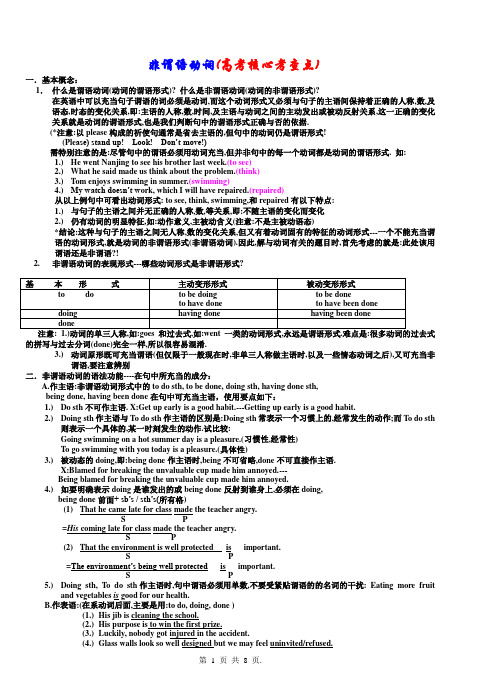
非谓语动词(高考核心考查点)一.基本概念:1.什么是谓语动词(动词的谓语形式)? 什么是非谓语动词(动词的非谓语形式)?在英语中可以充当句子谓语的词必须是动词,而这个动词形式又必须与句子的主语间保持着正确的人称,数,及语态,时态的变化关系,即:主语的人称,数,时间,及主语与动词之间的主动发出或被动反射关系,这一正确的变化关系就是动词的谓语形式,也是我们判断句中的谓语形式正确与否的依据.(*注意:以please构成的祈使句通常是省去主语的,但句中的动词仍是谓语形式!(Ple ase) stand up! Look! Don’t move!)需特别注意的是:尽管句中的谓语必须用动词充当,但并非句中的每一个动词都是动词的谓语形式. 如:1.)He went Nanjing to see his brother last week.(to see)2.)What he said made us think about the problem.(think)3.)Tom enjoys swimming in summer.(swimming)4.)My watch doesn’t w ork, which I will have repaired.(repaired)从以上例句中可看出动词形式: to see, think, swimming,和repaired有以下特点:1.)与句子的主语之间并无正确的人称,数,等关系,即:不随主语的变化而变化2.)仍有动词的明显特征,如:动作意义,主被动含义(注意:不是主被动语态)*结论:这种与句子的主语之间无人称,数的变化关系,但又有着动词固有的特征的动词形式---一个不能充当谓语的动词形式,就是动词的非谓语形式(非谓语动词).因此,解与动词有关的题目时,首先考虑的就是:此处该用谓语还是非谓语?!2. 非谓语动词的表现形式---哪些动词形式是非谓语形式?的拼写与过去分词(done)完全一样,所以很容易混淆.3.)动词原形既可充当谓语(但仅限于一般现在时,非单三人称做主语时,以及一些情态动词之后),又可充当非谓语,要注意辨别二.非谓语动词的语法功能----在句中所充当的成分:A.作主语:非谓语动词形式中的to do sth, to be done, doing sth, having done sth,being done, having been done在句中可充当主语,使用要点如下:1.)Do sth不可作主语. X:Get up early is a good habit.---Getting up early is a good habit.2.)Doing sth作主语与To do sth作主语的区别是:Doing sth常表示一个习惯上的,经常发生的动作;而To do sth则表示一个具体的,某一时刻发生的动作.试比较:Going swimming on a hot summer day is a pleasure.(习惯性,经常性)To go swimming with you today is a pleasure.(具体性)3.)被动态的doing,即:being done作主语时,being不可省略,done不可直接作主语.X:Blamed for breaking the unvaluable cup made him annoyed.---Being blamed for breaking the unvaluable cup made him annoyed.4.)如要明确表示doing是谁发出的或being done反射到谁身上,必须在doing,being done前面+ sb’s / sth’s(所有格)(1)That he came late for class made the teacher angry.S P=His coming late for class made the teacher angry.S P(2)That the environment is well protected is important.S P=The environment’s being well protected is important.S P5.)Doing sth, To do sth作主语时,句中谓语必须用单数,不要受紧贴谓语的的名词的干扰: Eating more fruitand vegetables is good for our health.B.作表语:(在系动词后面,主要是用:to do, doing, done )(1.)His jib is cleaning the school.(2.)His purpose is to win the first prize.(3.)Luckily, nobody got injured in the accident.(4.)Glass walls look so well designed but we may feel uninvited/refused.C.作宾语:所谓非谓语动词作宾语,就是将一个非谓语动词形式放在句中的谓语后面构成: 主+ 谓(P) + 动词(v)+ 其他的句式, 即:一个动+动的句式,其分类如下:1.普通类: S + P + to do/to be done + 其他. 注意:英语中大多数的动词后只可用to do,to be done作宾语(例外:help to do/do sth),但某些动词,词组后则可用不定式的各种变形形式作宾语,所以必须牢记这些动词和词组:( 1 )He pretended to work hard after he failed in the exam.(to work发生在谓语pretended之后)( 2 )He pretended to be working hard when the employer came in.(to be working与谓语pretended同时发生)( 3 )He pretended to have known the news when I showed him the newspaper.(to have known发生在谓语pretended之前)( 4 )All the food may happen to be eaten when we get the party, I’m afraid.(to be eaten发生在谓语happen之后)( 5 )All of them happened to be having dinner when we got to the party.(to be having与谓语happened同时发生)( 6 )All the food happened to have been eaten when we got to the party.(to have been eaten发生在谓语happened之前)( 1 )He is said to go to the U. S to study next year.(to go发生在谓语is said之后)( 2 )He is said to be writing a new novel at present.(to be writing与谓语is said同时发生)( 3 )He is said to have studied in the U. S.(to have studied发生在谓语is said之前)表三.具有虚拟含义的不定式:在下例动词,动词词组后用to have done, to have been done来表示:某人当时想做…,但( 1 )I would like very much to have joined you in the picnic.(我本非常愿意和你们一起去野炊)( 2 )I hoped/wanted/intended to have been invited to the party.(我真希望被邀请去参加了那个聚会)使用不定式的各种变形形式作宾语时的注意要点:( 1 )必须牢记哪些动词后面可用不定式的各种变形形式作宾语.( 2 )准确地判断句中该用不定式的主动类(to do, to be doing, to have done),还是被动类(to be done, to have been done),再判断时间(时态含义)上的区别. 因为语态含义是指不定式与句子主语之间的逻辑关系,是原则问题,而时态关系则是语境问题,是细微差别. 如:He happened _________(call) on when he was away.The scientists seem ______________(interest) in this field for a long time.*特殊情况中的不定式作宾语:( 1 )介词but, except(除…之外)后面既可跟to do sth,也可跟do sth用法为:a.)当but/except前没有实意动词do的任何形式时:用to do sth;We had no choice at that time but to give in to him.He said nothing but/except to throw himself into the chair.b.) 当but/except前有实意动词do的任何形式时:用do sth:He did nothing in the morning but/except watch TV.All the day, he seems to have nothing to do but/except chat on line.( 2 )wh-词:what, who, which, when, where, how, whether, (why除外)后面都可以跟一个不定式的主动式:wh- + to do*主动形式to do,来表示这一动宾关系,而不是用被动形式to be done来表示.即:主动形式表示被动含义. They have never told me what _________.(选出所有错误).A. is to doB. to doC. is to be doneD. to be done.( 3 )why + do sth/ not do sth?构成的省略句与完整的问句含义完全不同:前者不是疑问而是祈使或建议.Come in. Why stand in the rain? You are free. Why not join us in the boating?2.重点类:1.S + P(特定动词后必须) + doing sth / being done2. S +P(特定词组后必须) + doing sth / being done3.S +P(特定词组含介词to后必须) + doing sth / being done表(一)后面必须跟doing sth / being done的动词(共28个)表(表(表(1.remember / forget / regret 后面跟to do sth时, to do表示的动作没有发生,而跟doing sth或有时跟having done则表示动作已发生2.mean的主语为sb时,后面常跟to do sth,而主语为sth时,必须跟doing sth,即:sb mean to do sth=sb want / intend to do sthsth mean doingHe never means to come to school late.If you come to school late again, it will mean your being punished.Doing it this way means asking for trouble.3.sb can’t help doing sth:禁不住/忍不住做某事sb can’t help (to) do sth:无法/不能帮助做某事I know nothing about machines so I can’t help (to) repair the car.4.sb try to do sth:某人尽力做某事sb try doing sth:某人试试看能否做某事Try solving the maths problem another way if you fail this way.D.作补足语:在主动态的句子中作宾语补足语;在被动态中作主语补足语,分类句式如下:1.普通类:A.主动态:S + P + sb/sth(宾语) + to do sth / to be doneB.被动态:S + be done + to do sth / to be done说明:1.)英语中的绝大多数可以跟宾语再跟宾补的及物动词都可以用以上主,被动句型2.)此时宾补和主补的形式一样They want me to email the company. They want the company to be emailed.I am wanted to email the company. The company is wanted to be emailed.2.重点类:S + P + sb / sth + do sth 2)S + P + sb / sth + doing sth 3)S + P + sb / sth + done具体动词见表:4.)搞清do / doing和done的区别5.)注意谓语变为被动态后补足语的变化E.作状语:A.用to do sth / to be done作状语1.)在句中作目的状语: (In order)to do sth / not to do sth / to be done /not to be done , S + P +…=S + P +…(in order /so as) to do sth / to be done / not to do / not to be doneHe climbed up the tree to see further. He spoke up to be heard in the huge hall.2.)在句中作结果状语:S + P + …, + only to do sth / to be done 某人做…结果仅仅…/ 仅仅被…S + P + …, + never to do sth / to be done 某人做…从未/在也不…/ 不被…He hurried home , only to find his house broken into. He spent much on the bet, only to be cheated.The reporter made it to the airport, only to be told that the movie star had departed.He left his hometown 20 years ago , never to be seen again / never to return again.注意区别不定式作目的状语和结果状语的要点如下:1.)含义上的区别2.)位置上的区别,结果状语不可前置句首3.)目的状语前面没有only, never4.)不定式在以下句式中充当结果状语: S + P + too + adj / adv + to doS + P + too + adj + a / an + n + to do S + P + so + adj / adv + as to doS + P + such + n + as to do Will / Would you be so kind / good as to do sth? =Will you please do sth?3.)在句中作方式/方面状语: The book is easy to buy/ to understand/ to borrow / to translate.*sb / sth + P( be 或其他系动词) + adj(easy, hard, difficult, comfortable, fit, dangerous等)+ to do此时不定式用以说明这些adj在…方面…掌握要点:1.)在本句式中,adj后面的to do与主语之间是一个被动反射关系,但却不可用to be done,即主动形式表示被动含义2.)因为句中的to do与主语之间是被动反射关系,所以这个to do必须是一个及物动词(vt),如果是一个不及物动词的to do就必须在其后面加上一个正确的介词.The girl is hard to get along _________.(with) The room is nice to live _______.(in)The stain(污迹)on my shirt is difficult to get rid ______.(of)The robbers found the bank easy to break _______.(into,错:in)Old ladies are considered easier to rob ______ something.(of)3.)此句式有可能与It be + adj for sb / sth to do sth / to be done 转换:The book is easy (for us) to understand. =It is easy (for us) to understand the book.=It is easy for the book __________________________________.4.)在句中作原因状语:1.)sb + be + daj + to do sth / to be done(动作将发生或与be同时发生)2.)sb + be + adj + to have done / to have been done(动作在be前已发生)I am glad to see you.(见面时讲,to see you与am同时发生)I am glad to have seen you.(分手时讲,to have seen you在am之前发生)I am glad to be given a chance to go to the U.S.A next year.(动作将发生,在am之后:将有一个机会)I am glad to have been given a chance to go to the U.S.A in1998.(动作已发生在am之前:曾有一个机会)B.doing和done在句中作状语:doing和done在句子中可以充当:时间,原因,条件,让步,伴随(补充说明)等状语.其本质是将一个对应的状语从句(时间,原因,…)进行了简化,其要点之一是:状语从句中主语必须与主句中的主语为同一个人,物,事才可进行这种简化.换言之,简化后的doing短语,done短语必须与句子的主语之间有正确的逻辑关系:主动发出或被动反射.*doing和done作状语的两种基本句式:1.)原始从句: 时间/ 条件/ 原因等连词+S1 + P (主动态)+ …+(主句)S + P+…简化后: Doing sth / Having done sth +(主句)S + P…(不变)2.)原始从句: 时间/ 条件/ 原因等连词+S1 + P(被动态)+…+(主句)S + P…简化后: Done / Being done / Having been done +(主句)S + P…(不变)(1)If you heat the ice, you will get water. =Heating the ice, you will get water.(2)If ice is heated, it will become water. =Heated, it(ice) will become water.*(3) If the ice is heated, you will get water.S1 S2(本句无法用doing或done来简化从句, 只可用:With + sb / sth A + doing / done, + SB + P…)With the ice heated, you will get water.) 掌握要点:1.)判断该用从句还是简化式: doing sth / done2.)判断句子的主语与非谓语动词的逻辑关系:主动发出用doing sth / having done sth,被动反射则必须用:done / being done / having been done之一3.)doing sth相当于主动含义的正在进行时,一般现在时,一般将来时,一般过去时的时间含义,having done sth则相当于主动含义的现在/过去完成时含义.4.)done相当于被动态的一般现在,一般将来,一般过去的时间含义, being done相当于被动进行含义, having been done相当于被动完成含义5.)when,while,until,once(一旦), unless, if, as, though等词可放在doing sth或done前面,以具体表明doing sth / done 的状语含义6.)以下doing不受句子主语的控制:Generally / Frankly / Strictly speakingJudging from / by ….Thinking about…Considering… }+ S + P….Allowing for…Given…Talking about / Speaking of ….再次提醒: 用谓语(从句)还是非谓语(doing / done)是原则问题用主动形式(doing / having done)还是被动形式(done / being done /having been done)是原则问题,用哪种时态形式是语境问题F.作定语:所谓用非谓语动词作定语,就是用一个非谓语动词/词组去修饰一个名词1.)非谓语动词作定语的位置:单个的非谓语动词作定语要前置于被修饰的名词(left除外,the food left;比:the left food)而非谓语动词词组作定语则要后置2.)非谓语动词作定语的原理:就是将一个定语从句简化为一个定语词汇或词组,其规则如下:(1)名词+ that / which / who + P(主动语态)…to do sth(主动将来含义)简化:名词+{ doing sth(主动一般或主动进行含义)having done (主动完成含义)(2)名词+ that / which / who + P(be done:被动态从句)to be done(被动将来含义)done(被动一般含义)简化:名词+ { being done(被动进行含义)having been done(被动完成含义)因此,当我们难以确定该用非谓语的何种形式来作定语时,我们可以用从句还原法来帮我们一把.例:When we arrived at his house, we couldn’t see any ___?______(remaining, remained) gusests there.=When we arrived at his house, we couldn’t see any guests who _____?_____(remained,were remained)there.(remained)由此可见一个及物动词的各种非谓语形式都有可能作定语,而一个不及物动词的非谓语形式中的: tobe done, done, being done, having been done是无法作定语的(特例除外),因为它们本身就不存在! 如果存在就是一种人为的错误!特例:fallen, risen , set,可作定语:the fallen leaves, the risen sun, the set moon, 但不等于the fallingleaves, the rising sun, the setting moon;前者无被动含义而是完成含义, 后者则是进行含义.3.)只可用to do, to be done作定语的几种情况:1.)sb have(有) sth / sb to doI have something to say.(逻辑关系: I---say---something)She has a question to ask the teacher.(逻辑关系:She---ask---the teacher---a question)We have a new plan to talk about with you.(逻辑关系:We---talk about a new plan with you)2.)sb find sth to do3.)sbA give / offer sbB + sth to do*使用本句式时应特注意:1.)判断have是“有”动词而不是“使”动词.2.)被修饰的名词(sb / sth与后面的to do为被动反射关系,与句子的主语为主动发出关系,因此这个todo必须是一个vt,如果是一个vi,就必须在其后面+一个正确的介词,即:用to do的主动形式来表示与前面名词之间的被动关系!例:(1.)I have nobody to go to see the film_______(需要介词吗?) (with)(2.)He is said to have 3 children to bring___?___/ to raise___?____/ to care __?___.(up, /, about)(3.)We failed to find even a single bed to sleep ____?___ in the hotel.(in)(4)Would you please give a chair to sit ____?___?(in/on)(5)On Christmas Day, his mother gave him a new coat to dress.(改错)(dress---wear)3.)need, way, right(权利), chance, reason, 等词后面可用to do作定语.4.)被修饰的名词前有:the + 序数词/ the + last / the only + 名词+ to do sth / to be doneHe is always the first ( students) to ask questions.He is always the first (student) to be asked questions.关于非谓语动词教学的补充说明:独立主格结构I. 独立主格结构的基本概念由一个名词或代词作为逻辑主语,加上一个分词、形容词、副词、动词不定式或介词短语作为逻辑谓语构成,这种结构在形式上与主句没有关系,通常被称为独立主格结构。
- 1、下载文档前请自行甄别文档内容的完整性,平台不提供额外的编辑、内容补充、找答案等附加服务。
- 2、"仅部分预览"的文档,不可在线预览部分如存在完整性等问题,可反馈申请退款(可完整预览的文档不适用该条件!)。
- 3、如文档侵犯您的权益,请联系客服反馈,我们会尽快为您处理(人工客服工作时间:9:00-18:30)。
非谓语动词考查特点及解题点拨非谓语动词在英语语言中使用率很高,同时也是中考考考查热点。
近几年对非谓语动词的考查更加强调语句的复杂性,综合考查时态、语态、逻辑主语一致性的题目较多。
因此,考生必须学会在复杂的语境中选用非谓语动词的适当形式。
【例1】Charles Babbage is generally considered _____the first computer.A.to have inventedB.inventingC.to inventD.having invented解题点拨:这是一道把动词的用法和非谓语动词的用法结合起来的考题。
关键一:表示心理活动的动词在带不定式作宾补时常用to be或to have done,极少用to do sth.的形式。
关键二:注意consider的两种用法,consider doing sth.意为“考虑做某事”,consider sb./sth.to be 或consider sb.to have done或其被动式be considered to be/to have done意思是“认为某人/物如何(做了什么)”。
依题意可知本题考查第二种用法。
练一练:1)The patient was warned ______oily food after the operation.A.not eatB.eating notC.not to eatD.not eating【例2】Do let your mother know all the truth.She appears _______everything.A.to tellB.to be toldC.to be tellingD.to have been told解题点拨:这是一道把语态、时态、和非谓语动词结合起来考查的题目。
解这类题一定要注意时态和语态的变化,先于谓语动作发生的非谓语用完成形式。
前半句说“一定要告诉你母亲全部真相”,后半句说“看上去她好像已被告知所有情况”,因此选不定式完成形式的被动语态。
练一练:2)The old man is said _____a sailor when he was young.A.to have beenB.that he wasC.to beD.of being【例3】I can hardly imagine Peter ______across the Atlantic Ocean in five days.A.sailB.to sailC.sailingD.to have sailed解题点拨:本题考查的是动名词的复合结构及动名词作宾语时的情况。
动名词复合结构是在动名词前面加名词所有格、名词的普通格、物主代词、人称代词的宾格等。
如:Her not coming made the teacher angry.Do you object to my brother’s joining you?Would you mind me(my) opening the window?本题的解题关键是注意imagine后面只能接动名词作宾语,不用不定式。
解此类题时一定要明确动词搭配,记清哪些词接不定式、哪些词接动名词作宾语。
练一练:3)The next morning she found the man _______in bed,dead.A.lying B.lieC.layD.laying【例4】______a reply, he decided to write again.A.Not receivingB. Receiving notC. Not having receivedD. Having not received解题点拨:本题是对现在分词作状语的考查。
分词作状语时,一是考虑时间性(先后性),究竟使用分词的一般时还是完成时,二是考虑语态性,用主动语态还是用被动语态,三是看分词的逻辑主语是否是句子的主语。
本题中receiving的逻辑主语是he,即动作是主语执行的,故语态应为主动语态。
题干中的again这一关键信息提示考生,receiving动作发生在decided之前,应用现在分词的完成形式。
此外,本题还应该注意现在分词的否定形式的表达方式。
现在分词的否定形式是:否定词not必须置于动词-ing形式的前面。
练一练:4)The visiting minister expressed his satisfaction with his talks,_________that he had enjoyed his stay here.A. having addedB. to addC.addingD. added【例5】When the professor went back to the room,he found an invitation on the desk,_____to give a lecture in Princeton Institute.A. being invitedB.to be invitedC. inviting himD.invited解题点拨:本题的考查目标是现在分词作定语的用法。
现在分词作定语,强调动作正在进行,表主动用doing,若表被动则用being done。
letter(notice,message,telegram,invitation)等词后常跟-ing形式的动词作定语,表示letter等词的内容。
练一练:5) -Look! How busy the building workers are!—Yes,I see.The houses ____by them will be completed next week.A.builtB. to buildC.being builtD.are being built【例6】_____ that mistake once,I shall not make the same mistake again.A.To makeB.MakingC.Having madeD.Made解题点拨:该题考查的是现在分词的完成时的用法。
根据题意“已经出过一次错了,我不想再出同样的错误”,分词的动作先于谓语动词的动作,故要用分词的完成式having made作状语。
练一练:6) _____such heavy pollution already, it may now be too late to clean up the river.A. Having suffered B.SufferingC.To sufferD.Suffered【例7】_______ in 1636,Harvard is one of the most famous universities in the United States.A.Being foundedB.It was foundedC. FoundedD.Founding解题点拨:本题考查过去分词作状语的情况。
过去分词作状语,首先要考虑句子的主语是否是分词的逻辑主语,然后再考虑被动和完成的含义。
本句主语哈佛大学与动词found之间的关系应为被动关系,且建于1636年是发生在过去的动作。
练一练:7)_____ to make a speech, she had to say a few words.A. Having toldB. Having been toldC. To be toldD. Being told巩固练习:1. Finding her car stolen,_______.A. a policeman was asked to helpB. the area was searched thoroughlyC. it was looked for everywhereD. she hurried to a policeman for help2. The boy wanted to ride his bike in the street, but his mother told him______.A. not toB. not to doC. not do itD. do not to3. The news reporters hurried to the airport, only______the film stars had left.A. to tellB. to be toldC. tellingD. told4. The book is said______into many foreign language.A. to have been translatedB. to have translatedC. to be translatedD. having been translated5. Don’t leave the water_____while you brush your teeth.A. runB. runningC. being runD. to run6. In order to get to his house easily, I had his secretary______a map for me.A. to drawB. drawC. drawnD. drawing7._____in a heavy rain, the climbers had to stop climbing the mountain.A. CatchingB. Having caughtC. Being caughtD. Caught8. I bitterly regret______him what had happened to her yesterday.A. to tellB. to have toldC. tellingD. to be told9. The speeding car had missed the turn and now lay on its back, wheels______in the air.A. having spunB. spinningC. were spunD. spun10. When I got back home, I saw a message pinned to the door,_______"Sorry to miss you; will call later."A. readB. readingC. to readD. to be read练一练答案:①C ②A ③A ④C ⑤C ⑥A ⑦B练习答案: DABABBDCBB。
